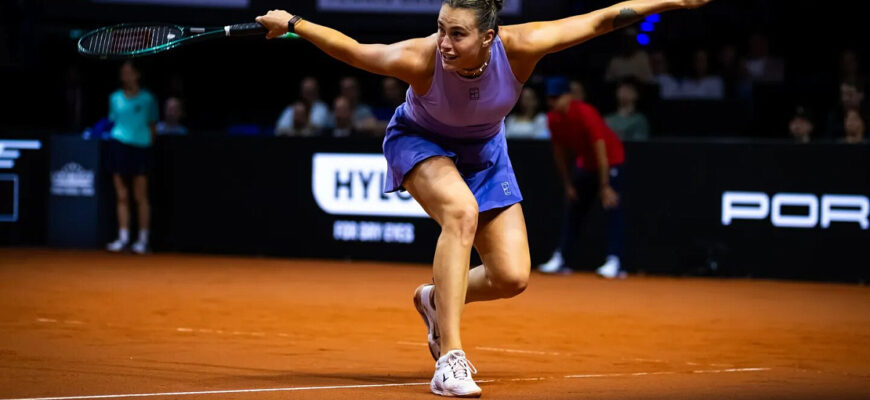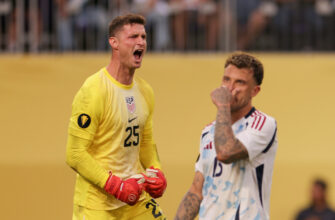MADRID — Demonstrating her evolving game, Aryna Sabalenka skillfully used a drop shot winner to wrap up the first game against Anna Blinkova on Friday. The second game concluded with the same tactic. A surprising serve-and-volley point secured a fifth consecutive game for Sabalenka.
Without question, variety is increasingly becoming a feature of Sabalenka’s formidable power game. This strategic evolution is a major factor behind her ascent to the top spot in the PIF WTA Rankings.
Looking ahead, these subtle yet growing additions—especially more frequent net approaches and drop shots—will be prominent in her play at the Mutua Madrid Open. Sabalenka triumphed over qualifier Blinkova with a 6-3, 6-4 score and is scheduled to face No. 28 seed Elise Mertens on Saturday.
“I think maybe on clay it’s a bit easier because the game overall is a bit slower,” Sabalenka commented during her pre-tournament press conference on Wednesday. “You have extra time.”
However, a contradictory thought then struck her.
“I don’t know, at the same time it’s easier and harder because I have more time and I have more options in my head,” Sabalenka said, laughing, “and sometimes I get confused.”
Leading the rankings by over 3,000 points and the 2025 Race to the WTA Finals by more than 800 points, Sabalenka is undeniably the premier player on the Hologic WTA Tour currently. Yet, she openly admits she is still figuring out how to best integrate variety into an approach that historically relied almost solely on raw power and strength.
“It’s a learning process and I’m not afraid to make mistakes,” Sabalenka stated. “I believe with time I will learn how to make the correct decisions. This will ultimately benefit my game. I think the clay court season provides a good opportunity to practice these specific shots.”
“You simply need to ensure you choose the right shot at the opportune moment.”
Moving Forward
Last autumn at the WTA Finals in Riyadh, Sabalenka’s coach, Anton Dubrov, discussed the team`s ongoing search for new elements to add to her game.
“We are trying,” he said, “to find areas where we can improve.”
This has been a continuous endeavor.
Two years ago, double faults were a significant problem for Sabalenka, casting a large shadow over her season. In 2022, she hit a staggering 428 double faults, the highest on the WTA Tour, resulting in a minus-179 differential when factoring in 249 aces. By adding biomechanics specialist Gavin MacMillan to her team, this issue was resolved.
In 2023, she recorded 404 aces against 285 double faults, achieving a dramatically improved plus-119 ratio. It`s likely no coincidence that Sabalenka won her first Grand Slam singles title in Melbourne during this period and has claimed three of the last five majors played on hard courts.
And now, the current strategic focus is indeed: moving forward.
Dubrov is well aware of common advice and has a rather clever response to suggestions like charging the net.
“Anyone can say, ‘Oh, yeah, she’s got to finish on the net,’” Dubrov explained. “That’s helpful advice, similar to, ‘Don’t hit double faults.’ That’s also great advice.”
However, it’s much easier said than done.
“It has to be at the correct time,” Dubrov emphasized. “Considering the structure of the point, you need to mentally prepare to finish the point at the net.”
Here is a chart from Stats Perform showing her net approaches leading into the clay season:

Notice the consistent increase in Sabalenka’s net approaches. When presented with the 2021-24 figures, Dubrov smiled, noting, “That’s a significant jump.”
Since Sabalenka has only played 30 matches so far in 2025, it’s premature to draw definitive conclusions for the current season. But in 2024, only three players—Tatjana Maria, Marta Kostyuk, and Leylah Fernandez—had more successful net approaches. Other players who frequently move forward and win points at the net include Elena Rybakina, Beatriz Haddad Maia, Jasmine Paolini, and Coco Gauff.
Variety Amplifies Power
This focus on moving forward is welcomed by Martina Navratilova.
The 18-time Grand Slam singles champion was a pioneer of aggressive net play in women’s tennis. One of her frustrations is seeing players fail to leverage their power to end points more quickly at the net. She has specifically mentioned Iga Swiatek and Sabalenka—the top two ranked players for over three years—in this regard.

How crucial is it that Sabalenka has incorporated this element into her game?
“It’s huge,” Navratilova asserted, “because the margins are so narrow. By not moving forward, you allow your opponent back into the rally, forcing you to start over. You significantly improve your chances of winning the point by moving forward and hitting the right shot, and consequently, improve your odds of winning the match. Every small gain helps.”
“Whether you make the shot or not—you’re attempting it. But moving forward or staying back is a deliberate choice. Sabalenka’s volley has improved, and she possesses greater variety. Having immense power is great, but when you complement it with variety, that power becomes even more effective.”
Jessica Pegula, who lost to Sabalenka in the Miami Open final, has also observed this development.
“She’s moving much better, and I think she’s being a bit more creative on court,” Pegula noted. “So suddenly, it’s not just her power; it’s a lot of these other aspects she’s improving that used to be less strong. I think she’s just broadly elevated many areas of her game.”
Similar to Sabalenka, Carolina Garcia is a power player known for her sometimes startling aggression. She believes modern fitness levels enable today’s players to achieve the best court coverage the sport has ever seen. Garcia explained that the sheer pace of shots from players like herself and Sabalenka often results in shorter balls coming back, creating ideal opportunities to finish points at the net.
“Going to the net is very beneficial because you save a lot of time against your opponent,” Garcia stated. “And sometimes it’s a bit simpler because the ball is slightly higher over the net, making it easier to finish. This is often preferable to letting the ball bounce, which slows down the point, requiring you to use power again and increasing the risk.”
“So it`s frequently an excellent way to conclude the point.”
Expect this strategy to feature even more prominently in the future.
“It’s still a work in progress,” Dubrov commented. “I’d say we are at about 50, 60 percent. It’s not fully mastered yet. But adding, say, five percent more net approaches every six months would be a huge gain.”
More Than Just a Drop
After securing the title in Wuhan last year, her third consecutive win after a four-year hiatus, Sabalenka spoke about her evolving game.
“I’ve improved significantly,” Sabalenka said then. “I can now approach the net and finish the point, and I can use my touch. I’ve added variation to my arsenal. I kept reminding myself that if I can’t powerfully hit or slice the ball, I should hit a drop shot and come to the net.”
“I was simply reminding myself that I have multiple weapons, not just hitting with power.”
Sabalenka mentioned that she could execute the drop shot effectively in practice. The challenge was incorporating it strategically into match points. Last year, during her match against Elina Svitolina in Rome—while already dealing with a shoulder injury that would force her withdrawal from Wimbledon—she deployed it out of necessity.
“The only viable option for me was to finish the point as quickly as possible,” Sabalenka recalled in Madrid. “I thought, ‘You know what, I’m going to go for the drop shots.’ I believe the best practice happens during a match. After that match, I realized, ‘Oh, this actually works, maybe we should work on this shot more frequently.’”
“Five years ago, if someone told me I would finally learn this shot, I would have laughed. I thought I had no touch, that I was terrible at it. Now, I have this shot available to me.”
The element of surprise can be a game-changer in any sport, particularly at the elite level. In tennis, serving wide when the opponent expects the ball down the middle is a winning tactic. Or hitting crosscourt when the situation suggests down-the-line. So, when Sabalenka’s powerful groundstrokes push opponents six or seven feet behind the baseline, she now has an additional option.
“When I see my opponent positioned very far back,” Sabalenka said, “I think, ‘Okay, I’ll just make them move.’ I am genuinely happy that I have finally, finally mastered this shot.”
“I actually have a certain degree of control over it, which honestly feels incredible to say. Yes, it’s just a valuable addition to my game, isn’t it? Good for me, less so for my opponents.”









